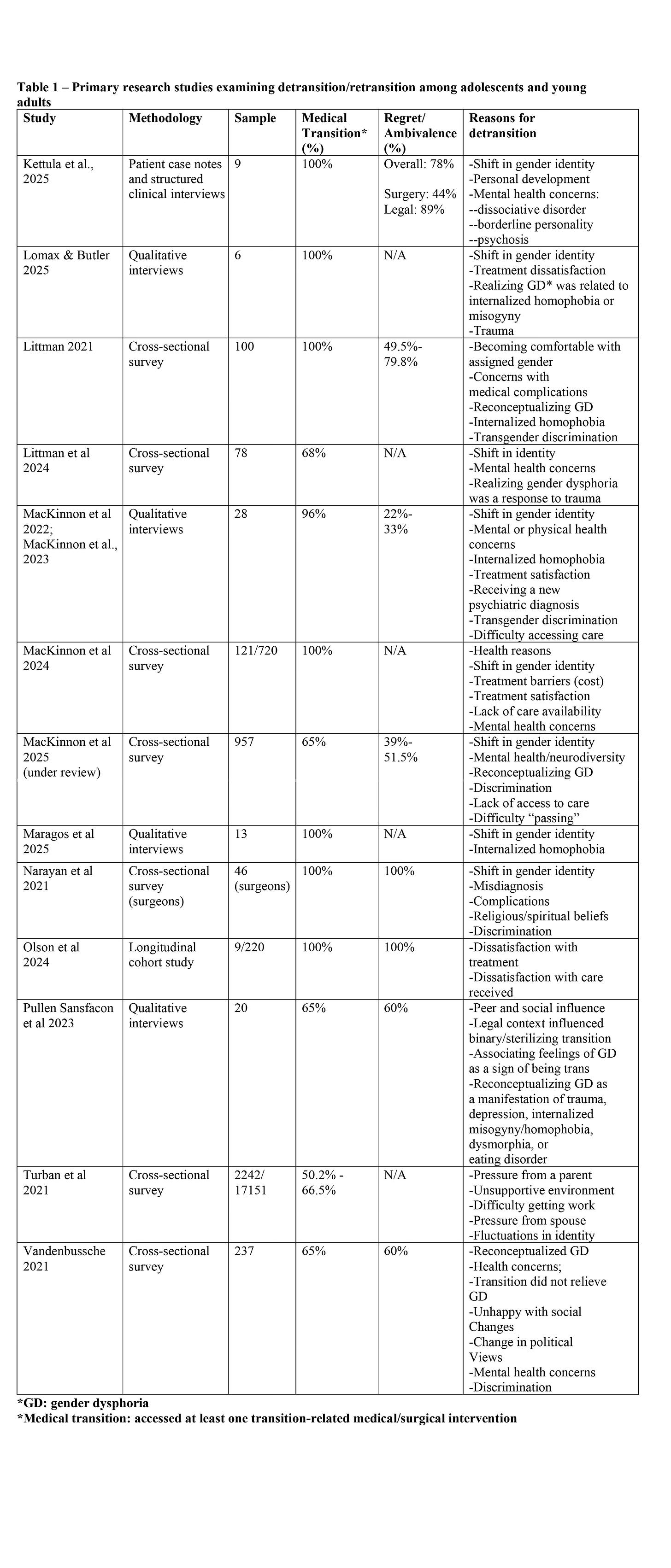The latest detrans research and current terminology
Today's post provides two handy resources for researchers, care providers, and anyone else with an interest in academic research on detransition/retransition.
A brief update: we are currently deep into a new project that we’re excited to share with you when the time comes. But that has meant for quieter periods here on our Substack. We didn’t want to leave you completely neglected, so we are sharing two resources that have come directly from recent academic work.
“We just need so much more information for people transitioning or de/retransitioning, like… how do people feel about it and how do they think about it?
… there is whatever percent of people do detransition, OK how many of them feel fucked up about it versus how many people feel pretty fine about it? Even that number doesn’t tell you what those emotions are like, as someone who’s trying to decide whether you should go forward with the transition or not.” -Participant #23, age 30, Re/DeTrans Canada study
Building on what we’ve discussed previously, this post provides two handy resources for anyone with an interest in research on detransition/retransition and transition-related care more generally. The first is a table of studies that report original data that were published in the last 5 years. And the second is a glossary of relevant terms and concepts.
These complement a post we previously wrote (about some of the factors identified from emerging studies, including some that are included in the table below):
What does research say about factors associated with detransitioning?
Research can help us make sense of people and populations in societies. As academics, we’re trained to look for patterns in data—identifying which elements repeat over time, and to compare and contrast findings across multiple studies.
First, we’re sharing a table that was created for an upcoming article intended for gender-affirming care providers. Because it is for a pediatrics journal, it provides summaries of recent research studies reporting peer-reviewed studies that are more relevant to providers who work with adolescents and emerging adults.
The table provides a simple break-down of the studies, such as the number of participants, the methodology used, and the key findings regarding why participants decided to discontinue medical treatments or detransition.
From the table below, you’ll see why we so often say that detransition/retransition is complex and multi-dimensional!
This is the complete list of references for the table, along with direct links to the articles so you can read them yourself:
Kettula, K., Puustinen, N., Tynkkynen, L., Lempinen, L., & Tuisku, K. (2025). Gender dysphoria and detransitioning in adults: An analysis of nine patients from a gender identity clinic from Finland. Archives of Sexual Behavior, 54(5), 1981–1990.
Lomax, J., & Butler, C. (2025). Narratives of adults registered female at birth who started a medical transition and later detransitioned. Archives of Sexual Behavior, 54(4), 1671–1686.
Littman L. (2021). Individuals treated for gender dysphoria with medical and/or surgical transition who subsequently detransitioned: A survey of 100 detransitioners. Archives of Sexual Behavior, 50(8), 3353–3369.
Littman, L., O'Malley, S., Kerschner, H., & Bailey, J. M. (2024). Detransition and desistance among previously trans-identified young adults. Archives of Sexual Behavior, 53(1), 57–76.
MacKinnon, K. R., Kia, H., Salway, T., Ashley, F., Lacombe-Duncan, A., Abramovich, A., Enxuga, G., & Ross, L. E. (2022). Health care experiences of patients discontinuing or reversing prior gender-affirming treatments. JAMA Network Open, 5(7), e2224717.
MacKinnon, K. R., Kia, H., Gould, W. A., Ross, L. E., Abramovich, A., Enxuga, G., & Lam, J. S. H. (2023). A typology of pathways to detransition: Considerations for care practice with transgender and gender diverse people who stop or reverse their gender transition. Psychology of Sexual Orientation and Gender Diversity, 12(1), 142–153.
MacKinnon, K. R., Jeyabalan, T., Strang, J. F., Delgado-Ron, J. A., Lam, J. S. H., Gould, W. A., Cooper, A., & Salway, T. (2024). Discontinuation of gender-affirming medical treatments: Prevalence and associated features in a nonprobabilistic sample of transgender and gender-diverse adolescents and young adults in Canada and the United States. Journal of Adolescent Health, 75(4), 569–577.
Maragos, A. C., Brown, C., & Allen, L. R. (2025). Lived experiences: Exploring detransition narratives. International Journal of Transgender Health, 26(1), 215–234.
Narayan, S. K., Hontscharuk, R., Danker, S., Guerriero, J., Carter, A., Blasdel, G., Bluebond-Langner, R., Ettner, R., Radix, A., Schechter, L., & Berli, J. U. (2021). Guiding the conversation—types of regret after gender-affirming surgery and their associated etiologies. Annals of Translational Medicine, 9(7), 605.
Olson, K. R., Raber, G. F., & Gallagher, N. M. (2024). Levels of satisfaction and regret with gender-affirming medical care in adolescence. JAMA Pediatrics, 178(12), 1354–1361.
Pullen Sansfaçon, A., Gelly, M. A., Gravel, R., Medico, D., Baril, A., Susset, F., & Paradis, A. (2023). A nuanced look into youth journeys of gender transition and detransition. Infant and Child Development, 32(2), e2402.
Turban, J. L., Loo, S. S., Almazan, A. N., & Keuroghlian, A. S. (2021). Factors leading to “detransition” among transgender and gender diverse people in the United States: A mixed-methods analysis. LGBT Health, 8(4), 273–280.
Vandenbussche E. (2022). Detransition-related needs and support: A cross-sectional online survey. Journal of Homosexuality, 69(9), 1602–1620.
The second resource is a glossary of relevant terminology and language pertinent to transition/detransition/retransition research. It was developed in 2022, following from research interviews as well as from our observations of language used by detransitioners and trans/nonbinary folks on social media. We feel these concepts are still relevant today, but, of course, they are always open to change in the future!
This glossary of terms was published in the BMJ as part of the article Detransition needs further understanding, not controversy, which we published along with Wren A. Gould, a collaborator for the DARE study.
Key concepts relevant to research and practice
Detransition—The process of discontinuing or reversing a gender transition, often in connection with a change in how the individual identifies or conceptualises their sex or gender since initiating transition.
Detrans—A term claimed by some people with an experience of detransition. This term is rarely thought of as a gender identity and is often used alongside another personal descriptor, such as detrans lesbian, detrans male, or detrans non-binary. Some people prefer the term detransitioner. These are all self-applied labels that should not be used to describe someone unless they use it themselves.
Gender dysphoria—A feeling of discomfort with primary or secondary sex characteristics. This term is used in psychiatric and medical settings to identify a clinical rationale for gender care, and it is often used to describe feelings of discomfort with birth assigned sex. Many trans and detrans people also use this word to describe their feelings of gender related distress. Gender dysphoria may also encompass iatrogenic, “reverse dysphoria”—that is, discomfort with primary or secondary sex characteristics following gender affirming medical or surgical interventions.
Questioning—The process of questioning your gender identity. Questioning can occur not only before initiating a gender transition but after transition, related to social, legal, or medical interventions. Before detransitioning, individuals may feel regret about their transition and question their identity or their decision to transition.
Re-identifying—A shift in how someone identifies and understands their sex, gender, or sexuality, often referring to a change from one identity to another. Some people re-identify as lesbian, gay, bisexual, or heterosexual after a period of affirming a trans identity and engaging in a gender transition.
Retransition—Resuming a gender transition following detransition. Some detrans people may use this term to indicate restarting hormone therapy for medical reasons but without re-identifying as transgender. Others may apply this word to refer to re-identifying since initiating a gender transition such as moving from a binary transgender identity to non-binary. Some people prefer retransition to describe stopping or reversing transition.
Transgender—An umbrella term inclusive of those who identify with a gender different from the one assigned to them at birth. Trans people may affirm a binary gender identity (woman or man) or an identity outside of the gender binary such as non-binary, genderfluid, or genderqueer. Some transgender people detransition because of stigma, social pressure, or discrimination in employment settings.
We hope these resources, including the summary table of recent studies and the glossary of key terms, help you navigate this topic. As the data clearly shows, there is no single narrative or reason for detransition. Recognizing this complexity and listening to the diverse experiences of individuals is essential for fostering a more nuanced and compassionate conversation about detransition, retransition, and gender identity fluidity.
We look forward to exploring these themes further in our upcoming work.
Thank you for reading The One Percent!
If you enjoyed this post, please share it with your friends, family, or colleagues:
You can also subscribe for free to receive new posts and support our work:







